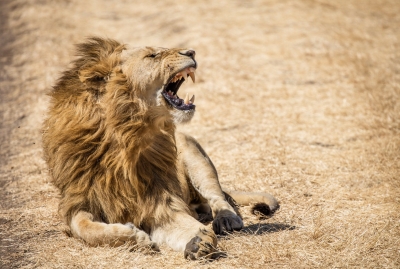
A lion’s roar is the loudest of all the big cats. Its roar can reach 114 decibels and can be heard miles away. This is because the lion has flat, square-shaped vocal cords, unlike the triangular vocal cords most animals have. This allows the lion to roar louder with less effort.
The science behind those majestic roars all comes down to one organ: the larynx (voice box). The vocal folds (vocal cords) of the larynx are different in lions and tigers than they are in other animals (even cheetahs can’t roar, as they belong to a separate genus).
In general, the “voice” of any animal (including humans) is produced by air (from the lungs) flowing past the vocal folds. This causes the vocal folds to vibrate, thereby “chopping up” the airflow. Due to this staggered output of air, audible pulses of sound are produced. The exact nature and volume of the sound depend on the air pressure from the lungs (meaning that air pressure is the “fuel” of our voices) and on the muscles of the larynx, which manipulate the exact length and tension of the vocal folds.
The difference between the vocal folds of Panthera cats and other animals is in their shape. While our vocal folds form a triangular shape within our throats, the vocal folds of lions and tigers form a square shape. This is due to the big cats having some fat depositions located deep within the vocal fold ligament.
It is due to this deposited fat that the vocal folds get their flattened, square shape. This shape essentially stabilizes the vocal cords, enabling them to better respond to the air as it passes by. In this way, lions can produce loud roars without exerting too much pressure on their lungs!
Credit : Science ABC
Picture Credit : Google




